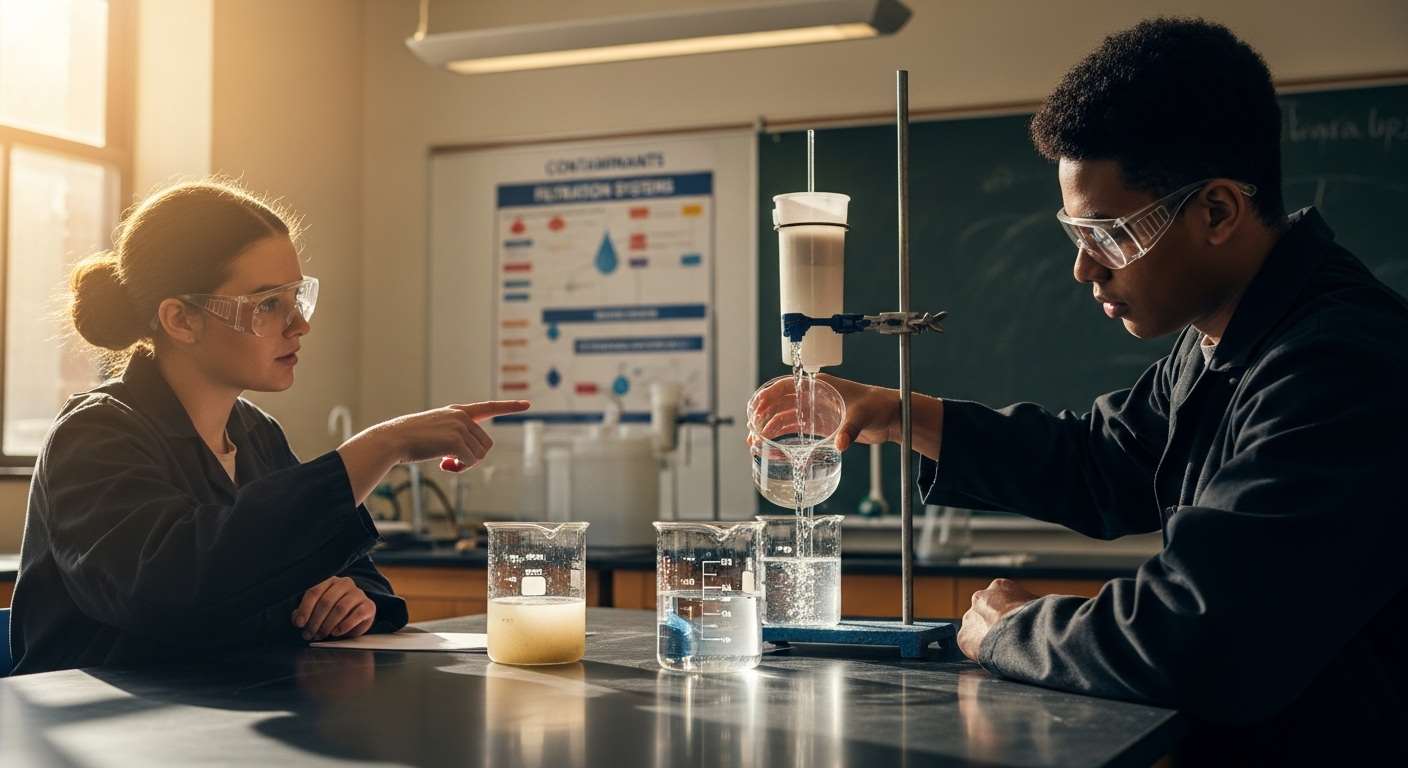Uncategorized
Understanding Water Purification Terms Explained Clearly
Everyone depends on safe drinking water, but even clear water from the tap can hide invisible dangers. Every year, contaminated water causes up to 485,000 deaths from diarrheal diseases according to the World Health Organization, which is a stunning reminder of what is at stake. What most people do not realize is that today’s purification systems can remove contaminants as tiny as 0.0001 microns, offering protection at a microscopic scale you cannot even imagine.
Table of Contents
- What Is Water Purification And Why It Matters?
- Key Concepts In Water Quality And Contaminants
- Common Water Purification Methods Explained
- Understanding Filtration Systems And Technologies
- Real-World Applications Of Water Purification
Quick Summary
| Takeaway | Explanation |
|---|---|
| Water purification safeguards health. | It removes harmful contaminants like bacteria and chemicals, protecting against waterborne diseases. |
| Contaminants come from various sources. | Natural and human activities, such as industrial discharge and agricultural runoff, introduce harmful substances into water. |
| Modern systems use advanced technologies. | Techniques like reverse osmosis and UV disinfection effectively eliminate diverse contaminants for cleaner water. |
| Filtration is crucial for water safety. | Mechanical and chemical filtration methods, including activated carbon, improve water quality and safety. |
| Water purification has diverse applications. | It’s essential in healthcare, agriculture, and industrial processes, ensuring water safety across sectors. |
What is Water Purification and Why It Matters?
Water purification represents a critical process designed to transform raw water into safe, consumable liquid by removing harmful contaminants, microorganisms, and potentially dangerous chemical compounds. When you turn on your tap, the water flowing out undergoes multiple sophisticated filtration stages to ensure its quality and safety.
The Essential Purpose of Water Purification
Understanding water purification starts with recognizing its fundamental goal: protecting human health. Every drop of water contains microscopic elements that could potentially cause serious illness if left untreated. Explore our comprehensive guide on water purification methods to understand how advanced technologies work to eliminate these risks.
Water sources naturally contain various contaminants, including:
- Bacteria and viruses
- Heavy metals like lead and mercury
- Chemical pollutants from industrial processes
- Agricultural runoff containing pesticides
- Sediment and organic materials
How Water Purification Protects Community Health
According to the World Health Organization, effective water purification is essential for preventing waterborne diseases that impact millions globally. The process involves multiple sophisticated techniques designed to remove or neutralize potential health threats.
The primary objectives of water purification extend beyond simple filtration. Modern purification systems focus on comprehensive contamination removal, ensuring that water not only looks clear but meets stringent health and safety standards. This involves a multi stage approach that combines physical filtration, chemical treatment, and advanced technological interventions to guarantee water quality.
By implementing robust water purification strategies, communities can significantly reduce public health risks, improve overall wellness, and create a foundation for sustainable water management. Water purification is not just a technical process but a critical public health intervention that protects individuals and entire populations from potential water-related health challenges.
Key Concepts in Water Quality and Contaminants
Water quality represents a complex ecosystem of physical, chemical, biological, and environmental factors that determine the safety and usability of water for human consumption. Understanding these intricate dynamics helps individuals and communities make informed decisions about water treatment and protection.
Types of Water Contaminants
Learn about our advanced water purification techniques that address various contamination challenges. According to the U.S. Environmental Protection Agency, water contaminants are categorized into four critical groups
![]() :
:
- Physical Contaminants: Substances that affect water’s physical properties, such as sediment or organic materials
- Chemical Contaminants: Naturally occurring or synthetic elements like nitrogen, metals, toxins, and pesticides
- Biological Contaminants: Microorganisms including bacteria, viruses, protozoa, and parasites
- Radiological Contaminants: Unstable chemical elements that emit ionizing radiation
Understanding Contamination Sources
Water contamination originates from diverse and complex environmental pathways. These sources range from natural geological processes to human industrial and agricultural activities. Industrial discharge, agricultural runoff, underground mineral leaching, and urban infrastructure can introduce potentially harmful substances into water systems.
The presence of contaminants can create significant health risks. Even minimal concentrations of certain chemicals or microorganisms can lead to serious medical conditions. Chronic exposure to contaminated water may result in long-term health complications, including developmental issues, neurological disorders, and increased cancer risks.
Proactive water quality management requires continuous monitoring, advanced filtration technologies, and comprehensive understanding of potential contamination mechanisms. By recognizing the intricate relationships between water sources, contaminant types, and potential health impacts, communities can develop robust strategies to ensure safe, clean water for all.
To help clarify the different types of water contaminants discussed, the table below summarizes each main category and provides a brief description of its defining features.
| Contaminant Category | Description |
|---|---|
| Physical Contaminants | Affect the physical properties of water, like clarity or color; examples include sediment and silt. |
| Chemical Contaminants | Include naturally occurring or man-made chemicals such as metals, nitrogen, pesticides, and toxins. |
| Biological Contaminants | Consist of microorganisms like bacteria, viruses, protozoa, and parasites that can cause diseases. |
| Radiological Contaminants | Unstable chemical elements that emit ionizing radiation, potentially posing serious health risks. |
Common Water Purification Methods Explained
Water purification involves multiple sophisticated techniques designed to eliminate contaminants and ensure safe drinking water. Understanding these methods helps individuals make informed decisions about water treatment and protection.
The table below compares some of the most common water purification methods, outlining their core mechanism and main contaminants they target for removal.
| Method | Core Mechanism | Main Contaminants Targeted |
|---|---|---|
| Filtration | Physical removal with membranes or filter media | Sediments, particles, some microbes |
| Reverse Osmosis | Semipermeable membrane under pressure | Dissolved solids, heavy metals, salts |
| UV Disinfection | Electromagnetic radiation neutralizes microbes | Bacteria, viruses, protozoa |
| Chemical Treatment | Addition of substances (e.g., chlorine, iodine) | Bacteria, viruses, some chemicals |
Fundamental Purification Techniques
Discover our comprehensive water filtration solutions that leverage advanced purification technologies. According to the National Sanitation Foundation, several core water purification methods stand out:
- Filtration: Physical removal of particles using membranes or media with specific pore sizes
- Reverse Osmosis: Forcing water through a semipermeable membrane to remove dissolved solids
- Ultraviolet (UV) Disinfection: Using electromagnetic radiation to neutralize microorganisms
- Chemical Treatment: Applying chlorine, iodine, or other chemical agents to kill harmful bacteria
Advanced Purification Technologies
Modern water purification goes beyond simple contaminant removal. Advanced technologies integrate multiple treatment stages to address complex water quality challenges. Activated carbon filtration, for instance, not only removes physical impurities but also eliminates unpleasant tastes and odors by adsorbing organic compounds.
Reverse osmosis represents a pinnacle of water purification technology. This method uses high-pressure systems to push water through microscopic membranes, effectively removing up to 99% of dissolved solids, including heavy metals, salts, and potentially harmful chemical compounds. The precision of reverse osmosis makes it a gold standard in water treatment.
Ultraviolet and chemical disinfection methods provide critical protection against biological contaminants. UV light disrupts the DNA of microorganisms, preventing their reproduction, while chemical treatments like chlorination destroy harmful bacteria and viruses. By combining these approaches, water treatment systems create multiple barriers against potential health risks, ensuring comprehensive water safety.
Understanding Filtration Systems and Technologies
Filtration systems represent a critical technological intervention in water treatment, transforming contaminated water into safe, consumable liquid through sophisticated mechanical and chemical processes. These systems leverage complex mechanisms to remove impurities and ensure water quality across residential, commercial, and industrial applications.
Core Filtration Mechanisms
Discover why regular filter maintenance matters for your health and the critical role of advanced filtration technologies. According to the Water Quality Association, filtration technologies operate through several fundamental principles:
- Mechanical Filtration: Physical removal of particles based on size and porosity
- Adsorption Filtration: Trapping contaminants on filter surface using activated materials
- Ion Exchange: Replacing harmful ions with safer, neutral ions
- Oxidation-Reduction: Chemical transformation of contaminants into less harmful compounds
Advanced Filtration Technologies
Modern filtration systems go beyond simple particle removal. Membrane technologies like ultrafiltration and nanofiltration utilize microscopic barriers with precisely engineered pore sizes to intercept contaminants at molecular levels. These advanced systems can remove particles as small as 0.0001 microns, effectively eliminating bacteria, viruses, and dissolved chemical compounds.
Activated carbon filtration represents another sophisticated approach. These filters use highly porous carbon materials with extensive surface areas to absorb organic compounds, chlorine, pesticides, and unpleasant odors. The intricate network of microscopic pores in activated carbon creates a complex trapping mechanism, providing comprehensive water purification beyond simple mechanical filtration.
Multistage filtration systems combine different technologies to create comprehensive water treatment solutions. By integrating mechanical, chemical, and advanced membrane technologies, these systems ensure multiple layers of protection against diverse contaminants, delivering water that meets the highest safety and quality standards.

Real-World Applications of Water Purification
Water purification technologies have evolved far beyond traditional treatment methods, finding critical applications across diverse sectors that impact public health, industrial processes, and environmental sustainability. These innovative solutions address complex water quality challenges in ways that extend well beyond simple drinking water treatment.
Critical Sector Applications
Learn about innovative under-sink water purification solutions that demonstrate the versatility of modern water treatment technologies. According to the World Health Organization, water purification plays crucial roles in multiple domains:
- Healthcare Facilities: Ensuring sterile water for medical procedures and patient care
- Agricultural Irrigation: Removing contaminants to protect crop health and soil quality
- Industrial Manufacturing: Preventing equipment corrosion and maintaining production standards
- Emergency Response: Providing safe drinking water in disaster-affected regions
Innovative Technological Applications
Water purification technologies now address complex environmental and health challenges. Cutting-edge research has produced specialized filtration systems targeting specific contaminants like heavy metals, pharmaceutical residues, and emerging pollutants. Nanotechnology-based membranes can now remove microscopic particles and dissolved compounds with unprecedented precision.
Emergency and remote location water treatment represents another critical application. Portable purification devices using advanced filtration and UV disinfection technologies can transform contaminated water sources into safe drinking water within minutes. These solutions are particularly vital in regions with limited access to clean water infrastructure, providing immediate protection against waterborne diseases.
Industrial sectors increasingly rely on sophisticated water purification technologies to meet stringent environmental regulations and sustainability goals. Closed-loop water recycling systems utilizing advanced filtration and treatment methods help industries dramatically reduce water consumption, minimize environmental impact, and create more sustainable operational practices.
Turn Water Purification Knowledge into Safe Solutions at Home
Now that you understand water purification terms and the real dangers hidden in untreated water, you might still wonder which solution can truly protect your family. The article explained how contaminants like bacteria, heavy metals, and chemicals threaten health, and why advanced filtration and UV sanitization matter. If choosing the right technology seems overwhelming, know that you are not alone. Many households struggle to match all those complex concepts—like reverse osmosis and multi-stage filtration—to an actual, effective product.
Find product answers that make sense for your needs on our Uncategorized Archives – Coway Water Purifier, where you can compare countertop, under-sink, and high-capacity purifiers. Each listing breaks down how Coway technology meets exact safety and performance standards, with science-backed systems designed for real household challenges.

Are you ready to move beyond confusion and secure safer water for your loved ones? Explore Coway’s range of water purifiers at https://cowayswaterpurifier.com today. Take action now and discover advanced filtration that truly puts your knowledge into practice. Clean, safe water is just a click away.
Frequently Asked Questions
What is water purification?
Water purification is the process of transforming raw water into safe, consumable water by removing harmful contaminants, microorganisms, and chemical compounds to ensure water quality and safety.
How does reverse osmosis work in water purification?
Reverse osmosis works by forcing water through a semipermeable membrane, effectively removing dissolved solids, heavy metals, and other contaminants to produce purified drinking water.
Why is understanding water contaminants important?
Understanding water contaminants is crucial because it helps individuals and communities identify potential health risks associated with contaminated water, leading to informed decisions about water treatment and safety.
What are the differences between physical and chemical water purification methods?
Physical methods, such as filtration, remove impurities based on size and porosity, while chemical methods involve adding substances like chlorine or iodine to kill bacteria and neutralize contaminants.
Recommended
- What is Water Purification? Understanding Its Importance – Coway Water Purifier
- 7 Effective Water Purification Methods for Your Home – Coway Water Purifier
- What is Water Filtration? Understanding Its Importance – Coway Water Purifier
- Understanding Air vs Water Purifiers: Key Differences Explained – Coway Water Purifier

